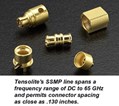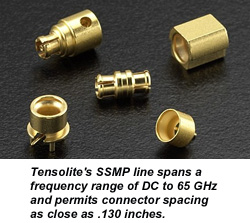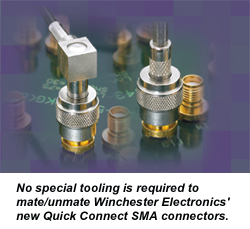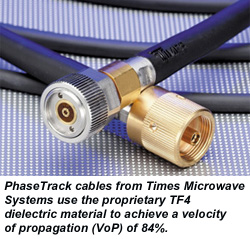RF Cables And Connectors Don't Get No Respect... But They Should

Ignore these inconspicuous components, and it's your loss -- they can bring major size, speed, and performance advantages to your design.
By Jim Pomager
Editor in Chief
Cables and connectors are quite possibly the most unglamorous components in the RF/microwave design world. (RFICs they most certainly are not!)
Like doorknobs in an architectural plan, RF cables and interconnects are rarely considered during the design process itself. Rather, these necessary evils are typically contemplated only after a project is all but complete. I've heard them aptly referred to as the Rodney Dangerfields of RF/microwave design -- they truly don't get no respect.
However, these oft-neglected components can have a significant impact on overall system performance. And with RF and microwave design engineers facing enormous pressure to deliver quality products at lower costs, cable and connector vendors can end up being their best friends, helping them meet a variety of electrical, mechanical, and environmental demands. In fact, today's cable and connector suppliers are supporting designers with products that are smaller, faster, and more phase stable than ever before.
Microminiaturized products handle higher frequencies, conserve space
There are two key factors behind the continuing reduction in RF cable and connector sizes. First, the frequency ranges of RF/microwave systems have been creeping steadily higher (driven principally by the need for higher data rates in communication systems). And small-diameter coaxial cables are generally more efficient at carrying the higher microwave frequencies than are large-diameter cables. Hence, we have witnessed the rise of small-diameter, high-frequency cable -- and the microminiature connector.
One line of connectors that illustrates this trend toward higher frequency and smaller size is the MMPX series from Huber Suhner. These board-mount, microminiature, snap-on connectors are comparable in size to the diminutive MMCX connector and are compatible with the MMCX interface. They demonstrate linear VSWR at frequencies from DC to 65 GHz and have shielding effectiveness of -85 dB from DC to 26.5 GHz, -65 dB from 26.5 to 50 GHz, and -60 dB from 50 to 65 GHz. Applications include test and measurement, defense, and mobile radio. MMPX connectors are available in straight cable plug, straight cable jack, right angle cable plug, straight PCB jack, edge-mount, PCB jack, and adaptor configurations. For more information, visit www.hubersuhner.com.
 Tensolite brings its SMP and SSMP lines of blind-mate push-on connectors to the microminiature party. The SMP series touts a frequency range of DC to 40 GHz and permits connector spacing as close as .170 inches for an assortment of military, space, and telecommunications applications. The SSMP series ratchets it up a notch in frequency (to 65 GHz) and down a notch in size (spacing to .130 inches) for smaller, lighter systems. SSMPs are offered in popular interconnection versions for cable assemblies, surface launch, edge launch, hermetics, adapters, and loads. For more information, download Tensolite's RF/Microwave Products Catalog.
Tensolite brings its SMP and SSMP lines of blind-mate push-on connectors to the microminiature party. The SMP series touts a frequency range of DC to 40 GHz and permits connector spacing as close as .170 inches for an assortment of military, space, and telecommunications applications. The SSMP series ratchets it up a notch in frequency (to 65 GHz) and down a notch in size (spacing to .130 inches) for smaller, lighter systems. SSMPs are offered in popular interconnection versions for cable assemblies, surface launch, edge launch, hermetics, adapters, and loads. For more information, download Tensolite's RF/Microwave Products Catalog.
The second major factor influencing RF cable and connector size is the shrinking of the RF/microwave system itself. With almost all package sizes getting smaller, real estate is now at a premium. As a result, cables and interconnects (all components, for that matter) must have minimal footprints, whether they are on a board, in a base station, or on a tower.
Nowhere is this lack of space more evident than inside a wireless device. For this cramped environment, RF Industries introduced the MHF series of microconnectors and cable assemblies for Wi-Fi. These coaxial connectors have a mating height of 2.5 mm. They support dual-band applications in the 3 to 6 GHz range, including laptops, PDAs, and cell phones. Cable assemblies are available with a range of connectors, including SMA, MMCX, TNC, and Type N. For more information, visit www.rfindustries.com.
Simplified connections prevent test and measurement headaches
Show me an RF/microwave engineer with too much time on his hands... and I'll sign him up to write a technical paper! Seriously, though -- most engineers are worked past the point of exhaustion these days, and as such would welcome any new technology that helps them complete tasks in an easier, faster, and more efficient fashion. In the test and measurement arena, where cables are constantly being attached/detached from instrumentation, recent advances in interconnect technology can help save engineers a lot of time (and a little sanity).
 Winchester Electronics just released its QC-SMA series of SMA connectors, which cover the frequency range of DC to 6 GHz. These connectors incorporate a push/pull style of mating, which allows them to be connected and disconnected without the need for special tooling. (This is in direct contrast to standard SMAs, which must be torqued for proper installation.) Once QC-SMA connectors are mated, they can rotate 360 degrees without losing connection. In addition to test environments, these connectors can also be used in microwave subsystems, base stations, mobile radios, and other applications. For more information, download the QC-SMA datasheet.
Winchester Electronics just released its QC-SMA series of SMA connectors, which cover the frequency range of DC to 6 GHz. These connectors incorporate a push/pull style of mating, which allows them to be connected and disconnected without the need for special tooling. (This is in direct contrast to standard SMAs, which must be torqued for proper installation.) Once QC-SMA connectors are mated, they can rotate 360 degrees without losing connection. In addition to test environments, these connectors can also be used in microwave subsystems, base stations, mobile radios, and other applications. For more information, download the QC-SMA datasheet.
Another recent addition to this space is the SMA Quick-Connect Plug from Emerson Network Power. This connector mates to standard, threaded SMA jack receptacles using a knurled thumbnut, which enables an electromechanical connection with a simple push-and-twist motion. One full turn, at most, is required to achieve Mil-C-39012 electrical compatibility. Disconnect is accomplished with a twist and pull motion. For more information, visit www.emersonnetworkpower.com/connectivity.
Advances in dielectric materials improve phase stability
As RF and microwave systems become more complex, they also become much more sensitive to variations in phase among their myriad components (as caused by environmental conditions such as bend or temperature). If the phase change of the components, including the cabling, is not predictable and consistent, the overall performance of the system can be compromised. Cable manufacturers are tackling this issue by manipulating the dielectric materials within their cables to make them less susceptible to changes in phase over a range of temperatures.
 For its PhaseTrack cable line, Times Microwave Systems created a proprietary dielectric material called TF4 to achieve phase stability in the face of temperature changes, such as may occur in test lab and production environments. These cables have a velocity of propagation (VoP) of 84% and a phase change of less than 1.5 parts per million (ppm) per degree from -55º to 85º C. They can handle frequencies ranging from .5 to 18 GHz, and feature a VSWR of 1.35:1 (maximum). In addition, the cable assemblies have removable front-end connectors that can be interchanged with other connector types. For more information, visit www.timesmicrowave.com.
For its PhaseTrack cable line, Times Microwave Systems created a proprietary dielectric material called TF4 to achieve phase stability in the face of temperature changes, such as may occur in test lab and production environments. These cables have a velocity of propagation (VoP) of 84% and a phase change of less than 1.5 parts per million (ppm) per degree from -55º to 85º C. They can handle frequencies ranging from .5 to 18 GHz, and feature a VSWR of 1.35:1 (maximum). In addition, the cable assemblies have removable front-end connectors that can be interchanged with other connector types. For more information, visit www.timesmicrowave.com.
To impart phase stability to its Phase Master® cable line, Storm Products developed what it calls MicroForm™ construction, which combines high-performance shielding technology with a proprietary blend of low-density polytetrafluoroethylene (PTFE) dielectric to achieve a VoP of 82%. Not only does this construction enhance phase stability within any single cable, it also provides repeatable, predictable performance for multiple cables in a temperature-sensitive system. The 0.190-inch-diameter Phase Master cable is available with a variety of connectors and protective armors and has an operating frequency of DC to 26.5 GHz. For more information, visit www.stormproducts.com.
